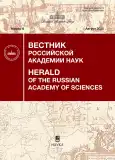INTELLIGENT DATA MINING IN MEDICINE: CHALLENGES AND OPPORTUNITIES
- Авторлар: Avetisyan A.I1
-
Мекемелер:
- V.P. Ivannikov Institute for System Programming of the Russian Academy of Sciences
- Шығарылым: № 8 (2025)
- Беттер: 53-57
- Бөлім: С КАФЕДРЫ ПРЕЗИДИУМА РАН
- URL: https://bakhtiniada.ru/0869-5873/article/view/305408
- DOI: https://doi.org/10.31857/S0869587325080053
- EDN: https://elibrary.ru/dtgcan
- ID: 305408
Дәйексөз келтіру
Аннотация
The article discusses modern challenges and opportunities for using artificial intelligence (AI) in medicine. It presents a Platform for creating models of intelligent analysis of biomedical data, developed within the framework of the world-class Scientific Center “Digital Biodesign and Personalized Healthcare”. The key aspects of the infrastructure required for processing medical data, as well as the results of testing the Platform on real biomedical problems are described. Particular attention is paid to the use of AI for analyzing electrocardiograms (ECG), classifying mammograms, detecting melanomas and solving bioinformatics problems. The article is based on the report at the meeting of the Presidium of the Russian Academy of Sciences on December 24, 2024.
Негізгі сөздер
Авторлар туралы
A. Avetisyan
V.P. Ivannikov Institute for System Programming of the Russian Academy of Sciences
Хат алмасуға жауапты Автор.
Email: arut@ispras.ru
Moscow, Russia
Әдебиет тізімі
- Artificial Intelligence (AI) in Healthcare Market: Growth, Size, Share, and Trends. https://www.marketsandmarkets.com/Market-Reports/artificial-intelligence-healthcare-market-54679303.html
- Национальная стратегия развития ИИ на период до 2030 года. https://ai.gov.ru/national-strategy/ National AI Development Strategy for the Period up to 2030.
- Andreev Р., Ananev V., Avetisyan A. et al. Non-architectural improvements for ECG classification using deep neural network // 2020 Ivannikov ISP RAS Open Conference. Pp. 64–68.
- Gliner V., Keidar N., Makarov V. et al. Automatic classification of healthy and disease conditions from images or digital standard 12-lead electrocardiograms // Scientific Reports 10, article number: 16331 (2020), pp. 1–13.
- Ananev V., Skorik S., Shaklein V. et al. Assessment of the impact of non-architectural changes in the predictive model on the quality of ECG classification // Proceedings of the Institute for System Programming of RAS. 2021, no. 33 (4), pp. 87–98.
- Avetisyan A., Tigranyan Sh., Asatryan A. et al. Deep neural networks generalization and fine-tuning for 12-lead ECG classification // Biomedical Signal Processing and Control, 2024, vol. 93, 106160.
- Skorik S., Avetisyan A., Diatlinko E. et al. Transferring Knowledge from 12-lead to 1-lead ECGs via Contrastive Learning // 2024 IEEE 48th Annual Computers, Software, and Applications Conference (COMPSAC). Pp. 1825–1830.
- Ибрагимов А.А., Сенотрусова С.А., Литвинов А.А. и др. Классификация наличия злокачественных образований на маммограмме с помощью методов глубокого обучения // Digital Diagnostics. 2024. Т. 5. № S1. С. 137–139. Ibragimov A.A., Senotrusova S.A., Litvinov A.A. et al. Classification of the presence of malignant tumors on a mammogram using deep learning methods // Digital Diagnostics. 2024, vol. 5, no. S1, pp. 137–139.
- Ibragimov А., Senotrusova S., Litvinov A. et al. MamT4: Multi-View Attention Networks for Mammography Cancer Classification // 2024 IEEE 48th Annual Computers, Software, and Applications Conference (COMPSAC). Pp. 1965–1970.
- Guguchkin E., Kasianov A., Belenikin M. et al. Enhancing SNV identification in whole-genome sequencing data through the incorporation of known genetic variants into the minimap2 index // BMC Bioinformatics, 2024 Jul, 13:25(1):238.
- Vishnyakova P., Poltavets A., Karpulevich E. et al. The response of two polar monocyte subsets to inflammation // Biomedicine and Pharmacotherapy, 2021, Jul. 139:111614.
- Sorokin M., Lyadov V., Suntsova M. et al. Detection of fusion events by RNA sequencing in FFPE versus freshly frozen colorectal cancer tissue samples // Frontiers in molecular biosciences, 2025, Jan. 21:11:1448792.
Қосымша файлдар









